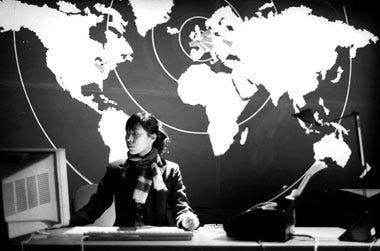Writing After the End — 2/4
From the archive: Secret agents surfing the seas of death, Freud's wolfman, and crypts decrypting and encrypting themselves — Tom McCarthy's Satin Island
Tune in to the singing tone poems of dial-up modems, Burroughsian cut-ups and the postures of emergent technologies in part two of my ‘Writing After the End of Writing’ feature from 2015.
**
A couple of months later, we’re speaking over a Skype video call. As we talk the image stutters in that familiar way, colours decaying and refracting at the edges as variable bandwidths compress our data and digitally tinge our voices into echoes of the singing tone poems of dial-up modems. Thinking back, I ask myself what a literary double-o agent would actually be? An author who was using language to subvert or re-engineer culture and society? Through the low-level network noise, an encryption of sorts tracing the wires, subroutines and pathways our exchange takes in the network of communication servers linking us, I ask T. about the connection between agents and writers. Are writers in some sense ‘secret agents’?
“Burroughs’ idea of the writer is that he’s some kind of agent,” affirms McCarthy in response. “He’s either called into action by a command elsewhere within a network of other agents or he himself activates these agents through his symbolic interventions. His media hack activates a whole other network of sleepers; he turns people into agents.”
“There’s a line that Burroughs and Brion Gysin sampled a lot, 'Calling all active agents, recalling all agents, calling all reactive agents', and all these permutations. This seems to really sum up the way he sees what it is to write. With Burroughs you’re being called by the underground into active acts of sabotage.”
Or almost infected perhaps? I offer.
“Yes, this whole viral structure of language and writing is something that appeals to me very much. In Satin Island I play with both sides of what it would mean to be an agent. My hero at one point has these very Burroughsian fantasies of sabotaging everything, using his insider status as a corporate anthropologist to put badass data into the system. But at the same time he’s very aware that he’s also an agent of power. He’s feeding his anthropological skill, all of which comes politically speaking from the left, back into the neoliberal machine. He’s a kind of double agent who harbours fantasies of becoming a triple agent, but then what if that just means you’re a quadruple agent and so on? So the whole idea of agency is very dissipated.”
As well as his writings, McCarthy has acted as General Secretary of the International Necronautical Society for over 15 years. The INS is a kind of fictive avant-garde revivalist group playing on the bureaucratic trappings of international bodies to explore and navigate the 'space of death'. One of the group’s early actions involved turning London’s Institute of Contemporary Art into an analogue radio broadcast station. Re-enacting the broadcasts out of Hades in Cocteau’s Orphée, McCarthy and his team used Burroughs and Gysin’s cut-up techniques to create fragments and random splices of text from newspaper articles. These found poems were read out on air as little lyrical ‘earworms’, hacked media voiced as calls to action.
If McCarthy has always been an agent of sorts, in person he can come across with an almost clandestine, guarded air. It’s not out of a sense that he is hiding anything, but on the contrary the feeling that McCarthy is about to reveal something. Reveal that there are secrets, even if they never quite breach the surface… like an ongoing unsheathing of a truth that could never quite be exposed. It is as if he is always on the cusp of an interrogation, eyes glinting brightly like a shrink who has sniffed out the faint scent of a breakthrough in the case.
My first encounter with T. was when he taught a course as part of my postgraduate studies. Active with the INS, with his first novel Remainder critically praised and other books being published with some regularity, he must have been writing his previous novel, C, at about this time. Also shortlisted for the Man Booker Prize, in 2010, C follows the short life of Serge Carrefax through the emergence of the early C20th's electro-modernity to explore ideas of transmission, death and mourning. Taking in similar themes, McCarthy’s course centred around reading Abraham and Török’s psychoanalytic studies of Freud’s famous ‘wolf man’ case. Their approach took the form of a ‘cryptonymy’: exploring anagrams, homophones, rhymes, puns and other word and sound plays as expressions of unconscious desires that circumvent the mind’s linguistic censorship. In other words, that a patient’s dreams can be decoded to reconstruct and expose a core, hidden truth or primal scene locked within a crypt deep within the psyche, and otherwise inexpressible to the conscious mind.
“In my last novel, C, that Abraham and Török book was a huge influence,” offers McCarthy when asked if these ideas carried over into his latest work. “[C] revolves quite literally around crypts, family crypts, encryption, and encrypted signals. It’s about the crypt of early late modernity, of the early 20th century. By Satin Island, which is set about 100 years on I guess, that has become a kind of digital crypt, the black box of the mysterious servers that basically organise every moment of our existence—including this one we’re having right now.”
Static crackles echo faintly in the Skype hinterlands behind T.’s voice.
“We are dwelling right now inside some black box in a Nevada desert and another somewhere in Finland and a black satellite up in the sky with some black box in Maryland doubtless listening in. Not even human black boxes, just crypts decrypting and re-encrypting each other.”
Non-human agents, I offer.
“Yeah, the whole human agency is pushed out to the side—it’s data reading data. Humans are implicated in that but we’re not the centre of it. We’re not the generators of it. We’re just kind of little flies in that mash, or affects of the network somehow.”
Is there a continuity between these two character, Satin Island’s protagonist U. and C’s hero Serge, I ask? Both characters experience similar kinds of emergent technologies that are transforming what connectivity, communication, and mediation itself are, but perhaps responding to them with different postures.
“It was funny to see the way C played out in the mainstream media. They saw it as a historical novel, but for me it wasn’t really at all. It was about new media, it was about empire, but it was an archaeology of the present moment. It had very contemporary concerns, but it was a Foucauldian archaeology of where we’re at now. With Satin Island it really is set now, it’s about now and it’s set now.”
“At the same time, [Satin Island]’s through-running premise is that the present is impossible; ‘now’ is an impossible kind of ontological situation, or an epistemological one. You can’t talk about now, there is no such thing as now, as the contemporary. So it’s a novel about the contemporary without a contemporary.”





